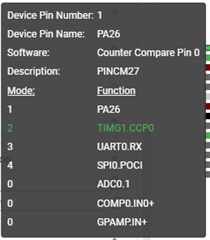Tool/software:
As shown in the attached image, Pin1/PA26 is being used as "TIMG1.CCP0".
And, a 40 kHz external clock is input to Pin1/PA26, but is it possible to output the external clock input to Pin1/PA26 from the microcontroller without dividing it?
Because other pins cannot be used as inputs, it is a must that Pin1/PA26 is set as "TIMG1.CCP0", an external clock is input, and that external clock is then output from the microcontroller.



